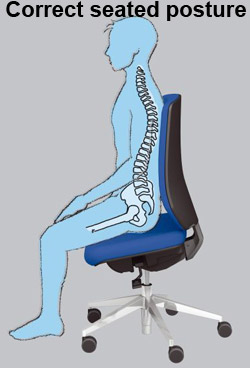National Back Week is from 6 to 12 September and offers the opportunity to take a closer look at preventing the back ailments that affect so many people.
Backache is one of the major health factors influencing a person's work performance and is responsible for a large percentage of lost working days.
Office workers spend up to 13 hours every day in a seated position, a posture that is actually deemed as unnatural for the human body.
"Although any healthy person could claim that they sit correctly, the fact is that no two people sit the same way,” says Malte Lenkeit, an ergonomic expert at the Dauphin HumanDesign Group.
Research into seating habits during workstation assessments repeatedly show that many office workers do not sit in the ideal position. Researchers have spent a great deal of time and energy analysing and defining suitable ways of helping people to sit correctly. However, the fact that these 'sitting norms' are static makes it impossible for people to adhere to them when concentrating at work.
Thanks to technology, office workers hardly have to get up anymore to file something or chat to colleagues, leading to long stretches of passive sitting in front of their desks. But Lenkeit warns that anyone who sits in the wrong position for longer than an hour a day is heading for health problems.
So what is the correct way to sit?
"Our bodies are better designed to be on the move, than spend long periods of time in the same position. Movement is therefore a decisive factor in the fight against the typical complaints of seated employees," says Debbie Arnoldi-Radford, MD of the Dauphin HumanDesign Group (South Africa).
Research has shown that a seat tilt of up to -12° is ideal. If the seat can tilt in this manner, the position of the pelvis when sitting comes close to its position when standing and this helps to minimise strain on the user's spinal column.
"Sitting in a balanced physical posture on an ergonomic office chair with a seat-tilt facility may seem strange to many people at first but in most instances people do not make the most of the features modern office chairs offer," says Arnoldi-Radford. "In our experience employees think that simply by adjusting their chairs they will be able to compensate for their incorrect posture and they do so continually, often without relief. For example, specific functions may be locked or the chair incorrectly adjusted. If this is the case, even the freedom allowed for micro movements will not help."
"By providing workers with an understanding of the importance of ergonomics in the workplace and of correct seating and posture, they are empowered to optimise their own workstations," says Andrew Todd, Lecturer at Rhodes University Department of Human Kinetics and Ergonomics and chairman of the Ergonomics Society of South Africa (ESSA). "Not only will they be able to ensure the appropriate match between the chair/desk and their own physical characteristics (stature, leg length), but also to incorporate appropriate rest breaks.
These breaks should be short and frequent and involve movement, for example alternating between sitting (60% of your day), standing (30%) and walking (10%), two to four times an hour. This will relieve the static contraction of the back and neck muscles, stimulate activity in the extremities, the heart and improve blood circulation. As a rule, five minutes of active stretching and training of the back musculature each day is better than half an hour once a week,” says Todd.
The science of sitting
According to Lenkeit experts unanimously agree that a "dynamic seated posture" is desirable as this prevents a one-sided strain being placed on the muscles.
A recent field study carried out by Drs Fritz Andreas Schön and Dieter Preim from the RWTH Aachen University in Germany shows that a dynamic seated posture requires both a specific degree of freedom and limits. The researchers analysed movement patterns at various workstations and determined what degree of freedom a modern office chair must offer in order to enable correct physical posture.
The researchers found that the laid-back or slouched seated position, often described as 'healthy', is in fact anatomically incorrect as it leads to excessive tension in the spinal column. At the same time, their assumption that people would favour the rear position when sitting on chairs with moving backrests turned out to be false. The researchers found that the opposite is true, with the forward seated position being more popular overall.
In view of this fact, the researchers looked at this posture in detail. They found that people can achieve a balanced seated posture if their pelvis is prevented from rolling backwards in this position. This in turn can be achieved by having a seat surface that automatically tilts forward depending on the user's body weight. This causes the pelvis to tilt, taking the strain off it.
10 tips for healthy sitting
1. Always place your feet flat on the floor.
2. Always maintain contact with the backrest.
3. Correct your bearing if you slide forwards on the seat.
4. Avoid extreme bending to one side whilst seated.
5. Only reach down to objects near the floor by bending forwards over the legs.
6. Do not cross your legs when sitting forwards.
7. Practise active, dynamic sitting as often as possible.
8. Train an upright posture without backrest every now and then, provided the chair has an automatic seat tilt adjustment.
9. When standing up and sitting down, always bring the centre of gravity for the extended upper part of the body over your knees.
10. Perform regular exercise at your workplace.
- (Health24, September 2010)
- Issued and prepared for the Dauphin HumanDesign Group by Lisa van Leeuwen.
Read more
Health24's Ergonomics Tool
Healthy Workplace




 Publications
Publications
 Partners
Partners













